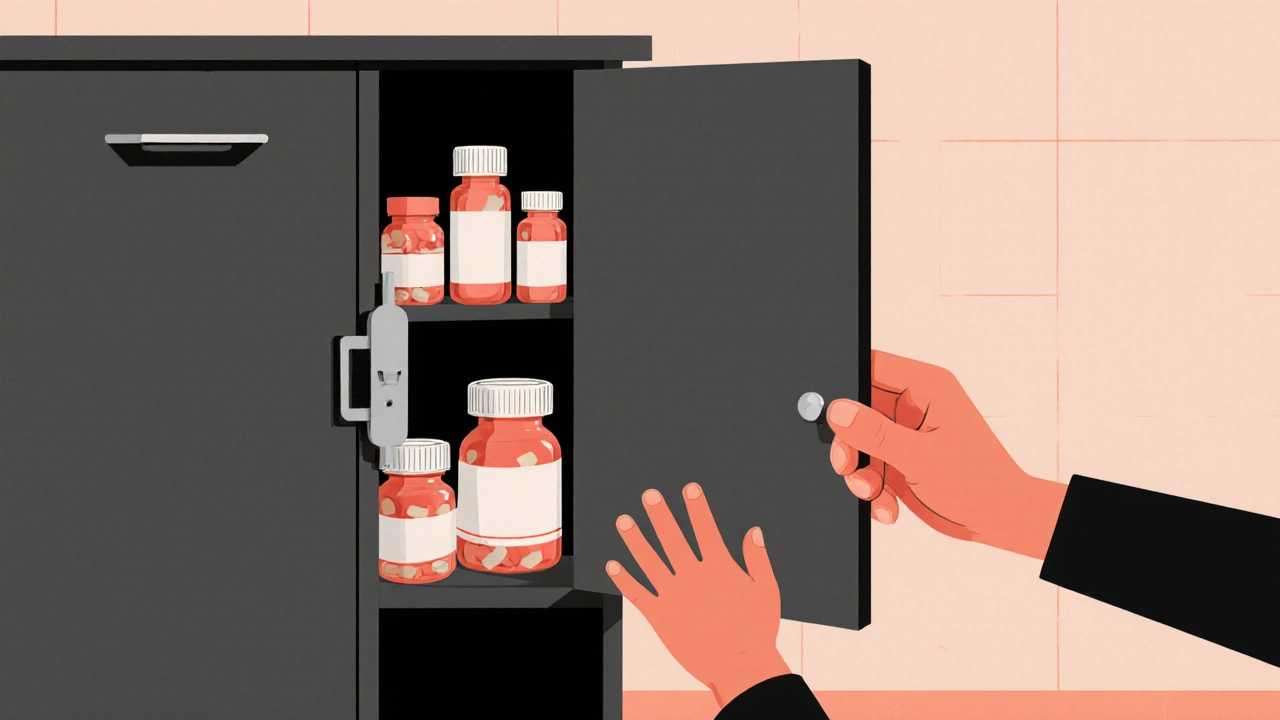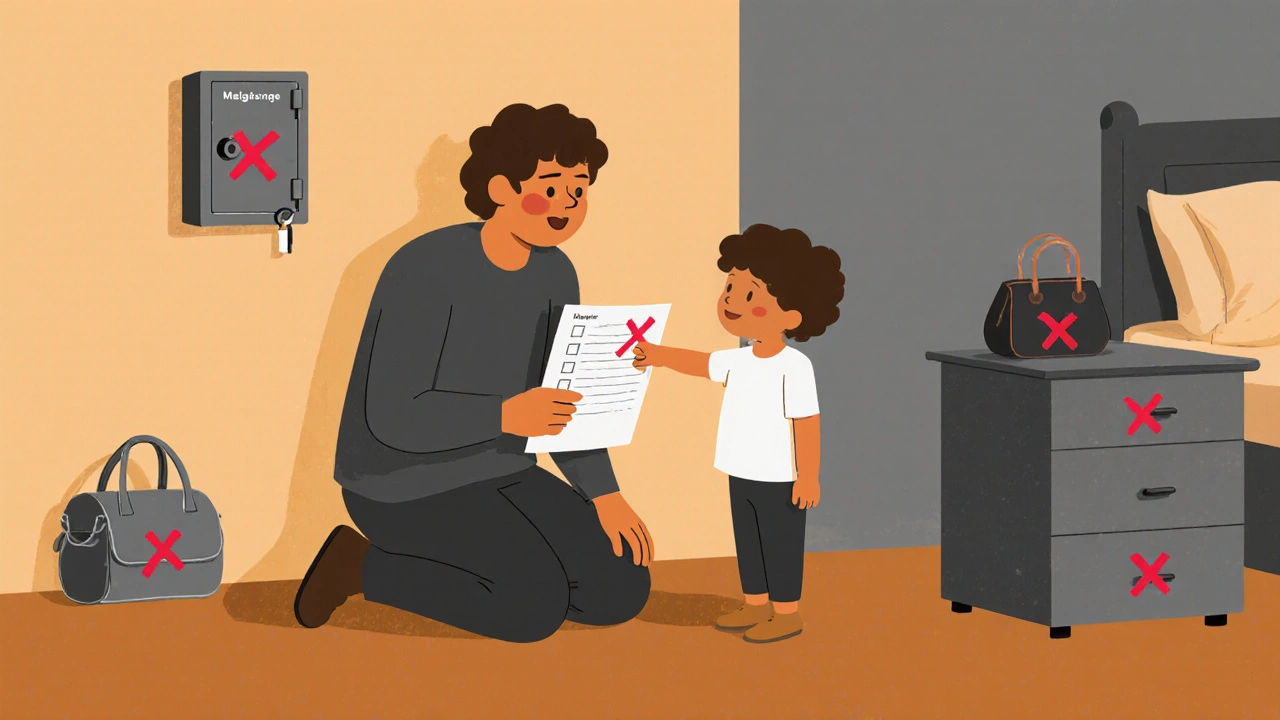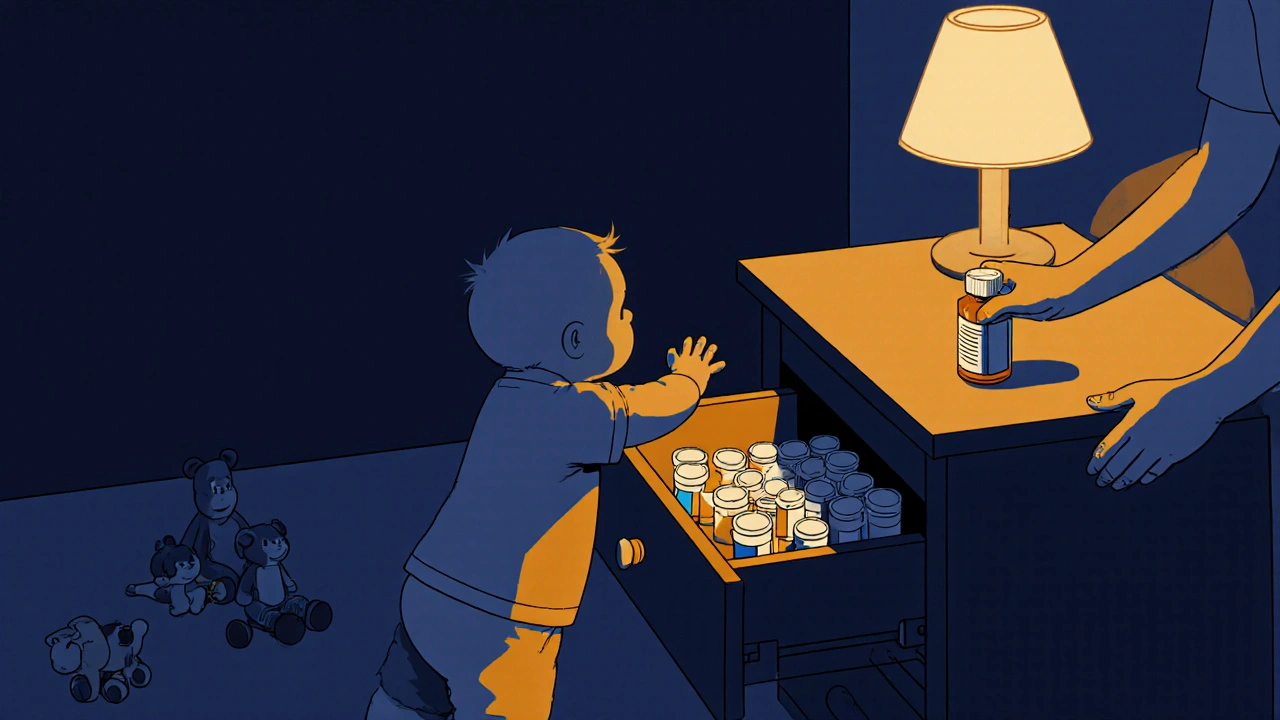Every year, tens of thousands of children end up in emergency rooms because they got into medicine they weren’t supposed to. It’s not because parents are careless-it’s because medicine is everywhere. On the nightstand. In a purse. On the kitchen counter. Even in a diaper bag left on the floor. And most of the time, it’s not the child’s fault. It’s the environment.
Medicines-whether prescription, over-the-counter, vitamins, or supplements-are the number one cause of poisoning in kids under five. In the U.S., about 60,000 kids visit the ER each year because they swallowed something they shouldn’t have. And in nearly 9 out of 10 of those cases, the medicine belonged to an adult. That means if you’re keeping pills in a place a child can reach, you’re putting them at risk-even if you think you’re being careful.
Stop Relying on Child-Resistant Caps
Many parents think: "I use child-resistant caps, so I’m safe." But here’s the truth: child-resistant doesn’t mean childproof. A 2020 study in JAMA Network found that even with these caps, kids under three can still open them in under a minute if they’re determined. And if you leave the bottle on the counter after taking your pill, you’ve already lost the game.
Child-resistant caps work only if they’re snapped shut every single time. And even then, they’re not enough. The CDC’s "Up and Away and Out of Sight" program says the only reliable way to prevent access is to store medicine where kids can’t see it or reach it. That means high, locked, and out of the way.
Where Medicines Are Most Often Found (And Why That’s Dangerous)
Most medication accidents happen in places you’d never expect.
- 78% of incidents come from nightstands and dressers-places where adults keep nighttime meds or pain relievers.
- 15% happen because a purse or diaper bag was left on the floor or couch.
- 12% occur from kitchen counters, where people leave pills while cooking or preparing a dose.
- 7% happen when pills fall during administration and get stepped on or picked up later.
- 5% are found under beds or in drawers kids can pull open.
Here’s the hard part: kids are climbers. They pull on curtains, stand on chairs, and reach for anything within sight. If a bottle is on a dresser next to a toy, they’ll go for the toy-and grab the bottle by accident.
Where to Store Medicine: The Only Safe Spots
There are only three places that actually work:
- High, locked kitchen cabinets - These are the most effective. About 76% of homes that use locked cabinets report zero incidents. Use a safety latch AND a lock. Latches alone only reduce access by 35%. Locks cut it to 89%.
- Top shelf of a linen closet - This is the second most popular choice. It’s out of sight, not near play areas, and usually has a door. 45% of families who childproof successfully use this spot.
- A dedicated medicine safe - These are small, wall-mounted or freestanding locks that hold pills, patches, and liquids. Sales have grown 32% year-over-year because parents are realizing they need more than a cabinet.
Never store medicine in the bathroom. Humidity ruins pills. And the mirror makes it look like a place for kids to explore. Never keep it in a drawer under the sink. Kids can open those.

Visitors Are a Hidden Risk
Here’s something most parents don’t think about: 28% of poisoning incidents involve medicine brought by guests. A grandma brings her blood pressure pills. A friend leaves their inhaler in a coat pocket. A relative drops their insulin pen in the diaper bag.
When someone comes over, make it easy for them to help. Say: "Can I put your bag in the closet? We’re keeping everything out of reach for the kids." It’s polite. It’s practical. And it stops accidents before they happen.
Never Call Medicine "Candy"
It’s tempting. You say, "This is your medicine candy," to get a toddler to swallow a bitter liquid. But research from HealthyChildren.org shows this increases accidental ingestion by 40%. Kids don’t understand the difference between "medicine candy" and real candy. They learn: if it looks like candy and tastes sweet, it’s okay to eat.
Instead, say: "Medicine is not candy. It’s for helping when you’re sick, and only grown-ups know how to use it safely." Simple. Clear. And proven to improve understanding by 58% in kids as young as two.
Dosing Errors Are Just as Dangerous
Even if your child never touches a bottle, they can still be poisoned by wrong doses.
- Kitchen spoons vary in size by up to 250%. A teaspoon could hold 2.5mL or 7.3mL. That’s the difference between a safe dose and an overdose.
- Acetaminophen and ibuprofen come in different strengths for babies and adults. One is 160mg per 5mL. The other is 320mg per 5mL. Mixing them up can cause liver damage.
- 40% of dosing errors happen when parents switch between teaspoons, milliliters, and drops without checking the label.
Always use the dosing tool that comes with the medicine: a syringe, dropper, or cup marked in mL. Never guess. Write down the dose, time, and name of the medicine on a sticky note if someone else is giving it. Communication errors cause 18% of incidents.

Dispose of Unused Medicine Properly
Don’t keep old pills "just in case." The CDC found that 22% of households keep unused opioids months after they’re no longer needed. And those pills are often the ones kids find.
Here’s how to dispose of them safely:
- Take unused pills out of their original bottles.
- Crush them or dissolve them in water.
- Mix with something unappealing-coffee grounds, kitty litter, or dirt.
- Put the mixture in a sealed plastic bag.
- Remove or black out your name and prescription info from the bottle.
- Throw it in the trash.
This method prevents 95% of accidental access during disposal. If there’s a take-back program nearby, use it. But if you live in a rural area-where 68% of homes don’t have one-this method is your best defense.
Start Talking to Kids Early
Even toddlers can learn. AGC Pediatrics says to start at age two. That’s when kids begin understanding simple rules. Say it every day: "Medicine is not for playing. Only grown-ups give medicine."
Studies show that kids who hear this message regularly from age three are 65% better at recognizing medicine as dangerous by age five. It’s not about scaring them. It’s about teaching them to respect it.
Weekly Safety Sweep
Set a reminder on your phone: every Sunday, do a 5-minute safety sweep.
- Check nightstands, dressers, and side tables.
- Look under beds and behind couches for dropped pills.
- Check purses, coats, and diaper bags.
- Make sure all caps are snapped shut.
- Throw away expired or unused meds using the disposal method above.
This habit cuts accidental access by more than half. It’s not about perfection. It’s about consistency.
Medication safety isn’t about buying expensive gadgets. It’s about changing habits. Putting things away after every use. Locking them up. Talking clearly to kids. And never, ever leaving a bottle out-even for a minute.
Every pill you store safely is one less emergency room visit. One less parent waking up in a panic. One less child who has to be rushed to the hospital because someone forgot to close a drawer.
Can child-resistant caps alone keep my child safe?
No. Child-resistant caps are designed to slow down kids, not stop them. Many children under three can open them in under a minute. The only reliable protection is storing medicine in a locked cabinet or safe, out of reach and out of sight-even if the cap is closed.
Where’s the safest place to store medicine at home?
The safest spots are high, locked kitchen cabinets or the top shelf of a linen closet with a door. Dedicated medicine safes are also highly effective. Avoid bathrooms, nightstands, dressers, and purses-these are the most common places kids find medicine.
Is it safe to keep medicine in a pill organizer?
Only if you’re actively using it for the week and you put it away immediately after. Pill organizers should never be left on counters or in accessible drawers. They’re for daily use, not storage. Always return unused pills to their original locked container.
What should I do if my child swallows medicine?
Call your local poison control center immediately. In South Africa, dial 0861 555 777. Do not wait for symptoms. Do not try to make your child vomit. Keep the medicine bottle handy so you can tell them what was taken, how much, and when. Time matters.
Can I use a kitchen spoon to measure medicine?
Never. Kitchen spoons vary wildly in size-from 2.5mL to 7.3mL for a "teaspoon." That’s a 250% difference. Always use the syringe, dropper, or cup that came with the medicine. It’s marked in milliliters (mL) for accuracy.
How do I explain medicine safety to a toddler?
Use simple, consistent phrases: "Medicine is not candy. It’s only for when you’re sick, and only grown-ups give it." Say it daily. Avoid calling medicine "sweet" or "yummy." Studies show this reduces accidental ingestion by 40%.
Are vitamins and supplements dangerous for kids?
Yes. Many vitamins look like candy-gummy, colorful, sweet. Iron supplements alone can be deadly in small doses for young children. Store them the same way as prescription medicine: locked, high, and out of sight.
What if I have to leave medicine out for a few hours?
Don’t. Even five minutes is enough time for a child to grab a bottle. If you’re giving medicine and need to step away, lock it in a cabinet first. Then come back. It’s better to be late than to risk an emergency.
Is it safe to store medicine in the fridge?
Only if the label says so. Most medicines are fine at room temperature (68-77°F). Storing them in the fridge doesn’t make them safer-it just makes them harder to find. And if the fridge is low enough for a child to reach, it’s a hazard. Always follow storage instructions on the label.
How often should I check my medicine storage?
Do a quick 5-minute safety sweep once a week. Check nightstands, purses, bags, and cabinets. Look for dropped pills. Make sure caps are tight. Throw away expired or unused meds. Consistency is what keeps kids safe-not one-time fixes.

Comments (11)